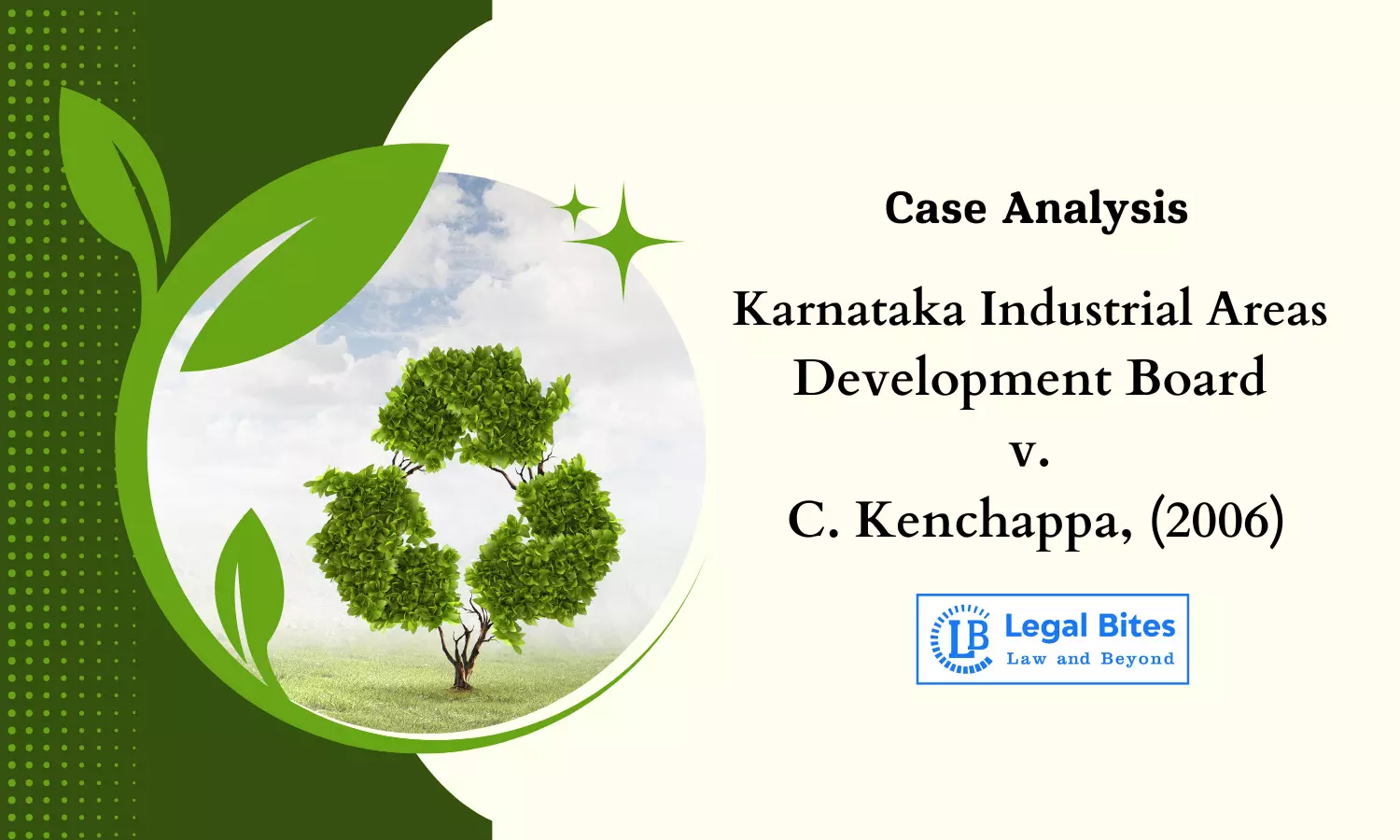Case Analysis: Karnataka Industrial Areas Development Board v. C. Kenchappa, (2006) | Sustainable Development
The Hon'ble Supreme Court ruled in favour of a balanced approach, recognizing the importance of both development and environmental conservation.

This case is a landmark in Indian environmental jurisprudence as it reinforced the need for sustainable development. It underscores the judiciary's role in ensuring that economic development does not occur at the expense of the environment and future generations.
Case Title: Karnataka Industrial Areas Development Board v. C. Kenchappa
Court: Supreme Court of India
Citation: AIR 2006 SC 2038
Facts
The present case was an appeal against a judgment passed by the Karnataka High Court. The same pertained to agricultural land acquisition by the Karnataka Industrial Areas Development Board. The respondents owned land used for grazing by cattle and other uses as they were agriculturists. The land however was a part of the major acquisition made by the Karnataka Industrial Areas Development Board. The acquisition was made under the aegis of the comprehensive development plan that had to be implemented in the ‘green belt’; the lands were included in the said green belt.
As they were wrongly affected by the said acquisition, the respondents had filed a petition under Article 226 of the Indian Constitution. Their prayer was to restrain the appellant from making the said land a part of any industrial development or other uses. It is important to note that this petition was quashed by the Karnataka High Court by quoting Section 3(1) of the Karnataka Industrial Areas Development Board Act, 1966.
The said provision gave the state government the ultimate power to declare any area under the jurisdiction of the state to be an industrial area and thus could acquire land as a result. The court while quashing the said petition also mentioned that Karnataka Industrial Areas Development Board had to leave a buffer zone of 1 km land on the outer periphery of the village to maintain the ‘ecological equilibrium’ with the hope that the same would assist in also reducing the pollution levels in the area.
The measure had also been directed with the idea of maintaining a green area towards the preservation of land for grazing cattle, agricultural operation and for development of social forestry. By this measure the court believed that it was doing justice to both the parties, thereby assisting the social needs without hampering the industrial development that was planned. As a thumb rule, the court directed that from now onwards in all cases of land acquisition for purposes such as industrial, commercial, and non-agricultural just except residential, it would be mandatory for the authorities concerned to spare a 1 km area on the outskirts of the village for maintaining ecological equilibrium.
The appeal, as mentioned above, has been filed by the appellants against this judgment of the Karnataka High Court. The appellants believed that post this order of the High Court, it would become impossible for them to acquire land for industrial development by way of the establishment and development of the industrial area in the State of Karnataka. They also stated the High Court exceeded its jurisdiction in ordering blanket directions which is tantamount to judicial legislation.
Issues
The main and major issue that was involved in this case pertained to the following aspects-
- Whether the order on land acquisition for industrial development is contrary to Section 3(1) and Section 47 of the Karnataka Industrial Areas Development Board Act, 1966?
Laws Involved
The laws involved in the present case are majorly the Karnataka Industrial Areas Development Board Act, 1966 and the Constitution of India.
Arguments Involved
Appellant
The appellant stated that by the order of the High Court, the court has exceeded its jurisdiction under Article 226 of the Constitution. The court is per se not permitted to issue any blanket directions as that would lead to the establishment of judge-made law. The same is prohibited as this would hamper the separation of powers mandate as established by our constitution. In addition, the appellant has also stated that by this order the High Court has thereby failed to acknowledge the fact that the lands in question have already lost their agrarian character quite a few years back and thereby providing judgment by keeping in mind that they are agricultural lands is not appropriate.
The appellant also mentioned that as per Section 3(1) of the Karnataka Industrial Areas Development Board Act, 1966, there is no requirement for issuing any notice to the land owners for acquisition and that Section 47 provides overriding power to the Karnataka Industrial Areas Development Board Act, 1966.
Respondent
They stated that deprivation of their land was a clear-cut violation of Articles 14 and 21 which provided them the right to equality and liberty. They stood by their submissions as made in the High Court as well whereby they stated that the appellant and the State of Karnataka have violated the zonal regulations in allotting the lands to Gee India Technology Centre Pvt. Ltd. was given the land that had been acquired the private owners.
Amicus Curiae’s remarks: The Amicus Curiae submitted that it was essential for a proper assessment to take place before the acquisition of the land involved in the development plan. As per him, it was of utmost importance to take into consideration the effects on the environment of industrialisation, with regards to the concerned area and also in place of the larger interest of the public.
Judgment
To decipher what the court stated while giving its judgement about land acquisition for industrial development being contrary to Section 3(1) and Section 47 of the Karnataka Industrial Areas Development Board Act, 1966, let us understand the following brief fragments as have been presented from the judgment of the court:
a. Requirement of Impact of Development, Project Clearance
The Supreme Court stated that they agree with the amicus curiae’s remarks whereby it had been mentioned that the appellant must conduct an impact analysis before acquiring any land for development purposes. In addition to that it is also the allottee’s responsibility to obtain necessary clearance for the project from the Karnataka State Pollution Control Board and the Department of Ecology and Environment before execution of the agreement.
b. Refrained from delving into the validity of Section 47 of the Karnataka Industrial Areas Development Board Act, 1966
The court refrained from delving into the intricacies of Section 47 of the Karnataka Industrial Areas Development Board Act, 1966. This was major because the respondents had not appeared before the apex court and as per the court, its decision on Section 47 of the Act may have had far-reaching impacts and ramifications.
c. Environment and Constitutional Provisions
While giving its reasoning relating to the necessity of environment and constitutional provisions to go hand in hand, the court referred to Articles 21, 48A and 51-A(g) of the Constitution. The court also referred to some of the landmark judgments whereby the matter relating to environment conservation and been adjudicated upon. The court referred to Essar Oil Ltd. v. Halar Utkarsh Samiti and Ors., [2004] 2 SCC 392, Indian Council for Enviro-Legal Action v. Union of India, [1996] 5 SCC 281 along with principles of action from the United Nations Conference on Environment and Development and the Stockholm Conference.
All in all the court attempted to reiterate the facet as to how maintaining balance between environment preservation and social needs is important. Neither of the two can be given more importance over the other. As per the apex court, economic development must not be permitted to happen at the behest of ecology or even by causing destruction of the environment and violation of the rights concerned. However, it is also simultaneously necessary to not curb any development equally.
As per the court, it is important to preserve both aspects and thus, development at the cost of the environment and refusal to develop, are both narrow-minded approaches. There is a requirement for balance to be created between the two.
The court further referred to environmental and legal principles such as the polluter pays principle, public trust doctrine and precautionary principle to decipher how the correct balance must be created between the two as has been proposed above- environment and development.
Final take on the directions passed by the Karnataka High Court:
The Hon'ble Supreme Court stated that post examining the said issue at hand from all the possible angles and delving into all the intricacies of environmental laws and principles at hand, it was of the view that the said directions passed by the Karnataka High Court must be set aside. The court stated that the directions as have been imposed by the High Court of Karnataka if implemented, may have far-reaching and obvious impact of restricting any type of land acquisition in future which certainly was not the objective of the court.
Thus the appeal was allowed and the directions were set aside.
Conclusion
This case is a very appropriate case for understanding how the available literature, case laws and environment-related principles have been put to use to decipher the major issue of creating a balance between environment conservation and development in general. The case has dealt with a vast variety of principles and case laws and the same makes it very intricate and rich in legal knowledge application. We can also see how the role of amicus curiae adds value to the court’s opinions and judgment. The case is thus a crucial landmark judgment in Environmental Law.

